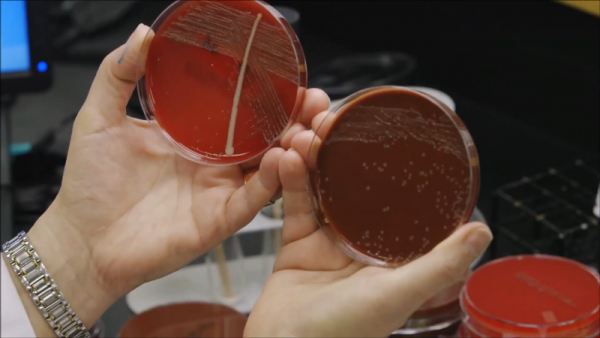By KM Diaz, | April 17, 2017

Haemophilus influenzae is associated with illnesses in young children. The superbug has six strains; the "type b" is the famous one that causes Hib.
Antibiotic-resistant superbugs are one of the threats to humankind. Scientists warn about the 12 superbugs because they "pose the greatest threat to human health." What's more alarming is that these superbugs cannot be seen, or smell.
Here's the list of the 12 superbugs published by World Health Organization.
Like Us on Facebook
1. Acinetobacter baumannii
Acinetobacter baumannii is associated with hospital room infections, and it is carbapenem (antibiotic) resistant. It starts to spread when military service members return from certain combat zones, like soldiers coming home from Iraq to the States.
2. Pseudomonas aeruginosa
Pseudomonas aeruginosa is also a carbapenem-resistant strain of bacteria, and it is critical on the list of bacteria becoming dangerously resistant to antibiotics. Pseudomonas aeruginosa affects patients staying at the hospital with weak immune system, and can also cause a disease to some plants and animals.
This particular superbug killed about 400 people per year, a small percentage of the 51,000 U.S. cases diagnosed annually, according to CDC.
3. Enterobacteriaceae
Enterobacteriaceae belongs to the third and final bacteria considered as critical by WHO. Again, this superbug is carbapenem-resistant, and ESBL-producing that can cause other complications like fever, urinary tract infections, pneumonia, and becomes harder to treat.
4. Enterococcus faecium
Enterococcus faecium bacteria is vancomycin resistant - an antibiotic used to treat infections in the intestines. Hence, this superbug causes infection in the gut, but it can also cause some infections in other parts of the body.
Aside from vancomycin, Enterococcus has started to show resistance to other treatments, like penicillin, making the infections difficult to treat.
5. Staphylococcus aureus
Staphylococcus aureus or MRSA (methicillin-resistant and vancomycin-resistant) is a nasty bug that can cause all kinds of infections, and in some cases, deadly. The bacteria is now learning to survive to the antibiotics developed to fight it that makes it harder to kill as it evolves.
6. Helicobacter pylori
According to WebMD, Helicobacter pylori earned a spot on the list of WHO because it is clarithromycin-resistant. This bacteria is commonly found in the intestines and stomach to cause complications in the digestive system.
The ulcer is the common issue among people who have Helicobacter pylori. The majority of people can carry the bacteria, but only a small subset experience problems.
7. Campylobacter spp.
Campylobacter is a fluoroquinolone-resistant, which literally means "curved bacteria." It is one of the most common causes of digestive problems, and can be fatal when patients with weak immune systems or children contracted it. It is transmitted as a food-borne illness since it exists in undercooked meat and animals.
8. Salmonellae
Salmonella is also food-borne illness and a fluoroquinolone-resistant bacteria just like Campylobacter. It is treatable, but some drugs are becoming less effective now. Medical experts suggest to properly cook eggs, bacon, and other preservatives.
9. Neisseria gonorrhoeae
Neisseria gonorrhoeae is sexually transmitted, fluoroquinolone-resistant and cephalosporin-resistant. It is one of the most well-known antibiotic-resistant gonorrhea because it is resistant to modern medicines and drugs making treatment difficult. WHO lists it as a high priority for new antibiotics.
10. Streptococcus pneumoniae
Streptococcus pneumoniae is a penicillin-non-susceptible that causes pneumonia and could cause another kind of infections. This superbug belongs to the final three priority superbugs listed by WHO.
11. Haemophilus influenzae
Haemophilus influenzae is associated with illnesses in young children. The superbug has six strains; the "type b" is the famous one that causes Hib. There is an available vaccine for the illness; however, it is an ampicillin-resistant bacteria.
12. Shigella spp.
Shigella spp. is transmitted through fecal contamination that leads to food poisoning. When ingested, it can cause a nasty infection. About 300,000 cases are reported every year.
-
Use of Coronavirus Pandemic Drones Raises Privacy Concerns: Drones Spread Fear, Local Officials Say

-
Coronavirus Hampers The Delivery Of Lockheed Martin F-35 Stealth Fighters For 2020

-
Instagram Speeds Up Plans to Add Account Memorialization Feature Due to COVID-19 Deaths

-
NASA: Perseverance Plans to Bring 'Mars Rock' to Earth in 2031

-
600 Dead And 3,000 In The Hospital as Iranians Believed Drinking High-Concentrations of Alcohol Can Cure The Coronavirus

-
600 Dead And 3,000 In The Hospital as Iranians Believed Drinking High-Concentrations of Alcohol Can Cure The Coronavirus

-
COVID-19: Doctors, Nurses Use Virtual Reality to Learn New Skills in Treating Coronavirus Patients












